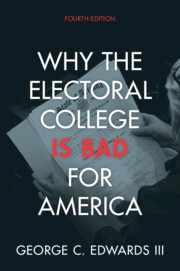Book contents
- Why the Electoral College Is Bad for America
- Why the Electoral College Is Bad for America
- Copyright page
- Dedication
- Contents
- Tables
- Preface
- 1 Raising Questions
- 2 How the Electoral College Works
- 3 The Electoral College and Political Equality
- 4 Contingent Elections
- 5 The Origins of the Electoral College
- 6 Protecting Interests
- 7 Maintaining Cohesion
- 8 Preserving the Party System
- 9 Conclusion
- Appendix US Constitutional Provisions Relating to Presidential Elections
- Notes
- Index
- References
1 - Raising Questions
Published online by Cambridge University Press: 09 November 2023
- Why the Electoral College Is Bad for America
- Why the Electoral College Is Bad for America
- Copyright page
- Dedication
- Contents
- Tables
- Preface
- 1 Raising Questions
- 2 How the Electoral College Works
- 3 The Electoral College and Political Equality
- 4 Contingent Elections
- 5 The Origins of the Electoral College
- 6 Protecting Interests
- 7 Maintaining Cohesion
- 8 Preserving the Party System
- 9 Conclusion
- Appendix US Constitutional Provisions Relating to Presidential Elections
- Notes
- Index
- References
Summary
The presidential elections of 2016 and 2020 were two of the most disconcerting in American history. In 2016, the winning candidate lost the popular vote by 3 million votes and never obtained the support of the public. In 2020, the incumbent president lost by 7 million votes. Instead of conceding defeat, he exploited the complex system of certifying the results to prolong the denouement of the election, attempting to subvert the U.S. democratic process. Both elections raise serious doubts about democracy in America. At the core of these misgivings is the electoral college.
Keywords
- Type
- Chapter
- Information
- Why the Electoral College Is Bad for America , pp. 1 - 17Publisher: Cambridge University PressPrint publication year: 2023



